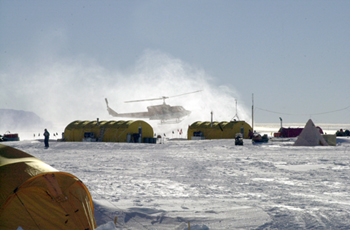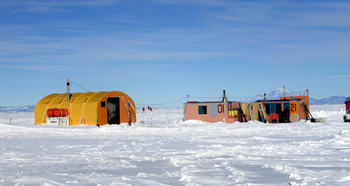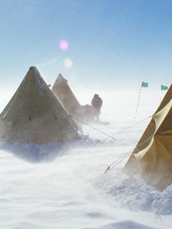|

Field Camps

MAJOR CAMPS
During some summer seasons, USAP establishes and operates one or more major summer research camps in areas of particular scientific interest. Typically these camps consist of Jamesways (quickly erected structures made of canvas and wood), and they support a population of 40 to 60 during the November-January period. Helicopters or Twin Otter airplanes are taken to the site and used to support local scientific operations. Skimobiles are also operated.
 |
Beardmore Camp, 2003-2004. |
Such camps have been operated in recent years at various locations on the Siple Coast, at "Beardmore South" in the central Transantarctic Mountains (1985-1986), northern Victoria Land (1981-1982), the Ellsworth Mountains (1979-1980), at Darwin Glacier in the Transantarctic Mountains (1978-1-979), and in the mountains of northern Marie Byrd Land (1977-1978). Geology, geophysics, glacial-geology, glaciology, and terrestrial biology have been pursued at these camps.

HUTS
If summer research projects are expected to continue over several seasons at the same location, huts may be erected. Huts, which can be expected to last for several years, provide space, stable working areas, and comfort not achievable with tents. Huts have been used in recent years in Taylor Valley (an ice-free or dry valley in southern Victoria Land) for study of lake ecosystems, at Cape Crozier on Ross Island for population and behavioral studies of penguin rookeries, and near the summit of Mount Erebus for volcanology. Resupply and transport are by helicopter or tracked vehicle from McMurdo Station.
| Huts at a sea-ice camp near McMurdo Station. |
 |

TENTS
Small parties requiring temporary shelter use single- or double-walled tents of several designs, both modern and traditional. These designs include the Scott tent, a pyramid shaped tent similar to the design used by Robert F. Scott early in this century. These tents are stable in high winds and can be erected quickly. Cold-weather sleeping bags are used on ground cushions, and cooking is by portable stoves. Tent camps usually are placed or moved by helicopter or Skimobile. Extended backpacking trips generally are not practical in Antarctica owing to the weight of the equipment and the fuel required to melt ice for water, to cook, and to combat the cold. All tent camps and huts are required to have radios, and they maintain daily contact with the nearest station.
 |
Tent camp. |
|





